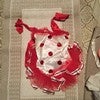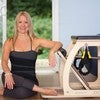Tutorial #3937
Find Your Footwork Placement
Description
You can find the Foot Board that was used in this video on the Pilates Lineage website.
About This Video
Transcript
Read Full Transcript
Hi, I'm Kathy Ross Nash here at [inaudible] anytime with my gorgeous model Mary, we're going to go over some foot position options for your reformer work. Use these options to find the best possible position for your student during their footwork. The purpose of footwork is anchoring and aligning from the foot through the spine, so if you don't have the muscles and bones directly lining up, you're actually going to do damage to your students, hips and knees and ankles and back. So it is imperative that you find the correct position that best suits your client might not be perfect. You work towards that. So the first is the classic [inaudible] position.
Where are you going to have your heels together, your toes apart, and you're about one hands with distance between the two large toes, you want to make sure that the entire ball of the foot is on the foot bar and that the weight is equally distributed. Lot of tendency will be to have the weight on the outer or inner part of the foot. You really want to dispense it right across the whole ball of the foot. The heels press firmly together. This is also a thing that you want to watch, that they don't press inward on the heel, that they actually are almost pressing a little further back than they think they need to to make the connection. This center line lines up with their midline. So we use this to start off with most students, but as we learn quickly, teaching is nobody who walks in that door is Mo will be most students.
So right, so one thing that you see a lot is you get people who are very hyper mobile or bowlegged for that student. I'm going to go into a very wide turnout. Now notice I'm not pushing her heels up at any point. I don't want those heels up. If the heels are up too high, she's going to be pushing into her joint. I don't want her to push into her joint. I want her to use her muscles.
That's where we're going to make change. So I'm going to go even go wider, man. Right? There you go. I'm going to go nice and wide for her. Not that she is bootlegged. If she had bow legs so that I can start drawing those legs towards the midline. It's also great for hyper extended people because a lot of times as they extend their legs, if they're not turned out enough, one leg will cross over the other.
This really helps to engage the inner thigh and draw them towards the midline. The next we have is parallel and together parallel and together happens to be one of my favorite positions. Ramana used to say that parallel and together the goal for all your foot placement. Okay, so you want to attempt to have the heels together and the knees together and this is not easy. It has to do a lot with the connection, the outer edge of the foot and the lift of the arch. When we get into props later, we'll see how if they can't get their heels and knees together in the balls together at the same time, how we're going to facilitate them to develop that muscularity. Okay, so I will use this for the greater amount of support. Who would that be?
Somebody who as they bend in extend one leg wants to extend faster than the other. Okay, so they go like leg. Also for people whose knees wobble or legs rotate in and out as they're pushing in and out. So I will use it for them. If I need to really give somebody midline information, I'm going to use this position. Then we have parallel hips with apart, I use this for knee issues, hip issues, ankle issues, foot issues, and also for people who are not need and can have their knees together with props so that they can help define their alignment. Okay, very, very important. So another thing I'm going to just quickly hit on is we have our foot positions as we know the ball of the foot, right? Stimulating the heart and lungs, your arches, the internal organs and the kidneys on the heel. When we're working our arch position, we actually have a couple different options.
One is to work right underneath the ball of the foot. Okay. When I'm right underneath the ball of the foot, I'm going to still be stimulating son of some of the sinus cavity and the breathing. I'll use this position for anybody that I know has asthma or an allergy. Really utilize the benefits of the reflexology. Okay? For most other people, I'm going to go more towards the middle of the foot, so I'm going to be stimulating the internal organs.
For any of you who've ever done foot rolling, the rolling exercises that we do can do in place and you've had an, let's just say a festive night out. You'll find that this position when you roll can be sensitive. It is so imperative for the internal cleanse that we really stimulate these pressure points in our feet. If we want to really work our bodies from the inside out in this position, I can work my ankle in three different positions. One is the way that I used to always work and that was with the heels wake dropped down a tiny bit more. Marry that with the heels way underneath. Okay?
You want this because as you're working your footwork, you're working the different points of propulsion where your foot pushes off from the middle part where she is now. So the foot is flat on the earth and the heel, which your foot is inflection and you're striking the earth. So as you go through your footwork, you're actually walking and going through all the movements that the ankle is going to need to go through when you walk. So this is the position that I used. Okay? Now if I have somebody and they have a tighter hip, I will lift their heels up. Go ahead, lift up, up, up, up there, and you feel how that releases your hip. Okay?
So if I have somebody who has a tight hip, I'm going to keep their heels lifted up. And then there are people that I will work in the mid point. And for those people a lot of times is people that'll go into their knees or into their joints. When you work at the mid point, they have to control the ankle position. They can't be dropping it and moving it and therefore it makes them more active throughout the entire leg. So now that we know our foot position options, we have our last one where you're flexing your feedback and you're on your heels. Okay. Really flat.
We're going to talk about some prop variations that we use and why we'd use them. So I wore, I used to train with Kathy grants in the 80s and she had this footboard and recently I had it copied. Um, and it was really interesting that this size and shape is the same diameter as the foot corrector. And I had no idea. I had had the foot correctors done and then they made this for me and we found out that they were the same diameter, which is really just cool. Right, right. So interesting. Um, so there were, my recollection is that there were two, there was one that was either fastened permanently on the reformer or it could be taken on an off and it was secure. And the one that was secure was used for newer students that could not get all the toes on the foot bar. The foot bars weren't padded in those days. They were metal and raw. And that's what I have at my studio. Um, and it's sometimes difficult to get the entire bowl, the foot on there. So Americ just come down into whatever position you're comfortable on and you see with this distance and it really doesn't matter. I've, I've had people with size, like 13 foot and you can still get the whole ball of the foot, doesn't it feel nice on there? So no matter what position your student works, whether they were way turned out or parallel or with their heels together and toes apart, you can really utilize this bar.
The other thing that this, um, foot bar does is it allows them to get the correct action of pushing through their foot. If you push up on this bar, it goes flying off. If it does. So sometimes if I'm mean, I'll just stand there and I'll go, go ahead and push and let's see how you do. Um, so it, it really tells you the truth of whether you're really connecting and utilizing the purpose of the footwork and really moving from your powerhouse as opposed to pushing with your legs on this bar. I usually begin with two Springs and gradually build up to four. It's very, very difficult. Now with newer students, since I don't have one that hooks on, I will hold onto the bar for their entirety of the footwork so that they can utilize the benefits of this board and not have to worry about it sliding off until they're proficient enough with understanding how to connect to their powerhouse when they move. So we have the footboard. Good. Thank you. Can people get this? They can. They can. Um, these lineage actually makes this, it just asks for the footboard and they make it, it's great. I, I have, I think every person that has come to my studio and use this has now has one and like for teachers imperative. Oh, we'll play with it later. It's so much fun.
Um, I mean, how many students do you have where they can't get their feet on? Right. Many, even myself, you know, we get into these sloppy habits sometimes in, this brings me back to pack to center. Okay. So then the other thing is good, let's bring your knees in as I will also utilize the jump board for footwork. I use this for a lot of reasons. Okay. If I have somebody in, they need a wider support for their foot.
This is a great place for you to do, isn't it? Feel great. Good. So she can lift her heels up and guess what? Now she doesn't have to worry about keeping anything on. She can really focus on her powerhouse. It gives much more support to the student. It's here, might not use it. Right. And then when she goes to her arches, she's right, doesn't it feel great? And even her heels.
Okay. It is, it's so great. And it's also, you know, intendant stretch when you have the person that drops their heels down and rotates in. When they do their tendon stretch here, they can't go below sea level. So prevent it makes it more about the control of the alignment rather than a sink down. Okay. And all the foot position options that I mentioned in the very beginning when I was using the footboard can be used on both of these little props. So it's not just limited to any, you can use it. Anything that I have discussed, we can put on these for the needs of your clients. So I love this and it feels good on your feet, especially if you have somebody with very sensitive feet.
The cushioning on here really allows them to, to feel the connection to their powerhouse without having to deal with the sensitivity of their feet. Excellent. Thanks. So now we get into propping toys. I love toys. Toys are good. Um, so contrary to popular belief, you know, I trained a lot with Romana and people think she didn't use pillows and towels and, and she did. Um, you know, the whole thing with Pilati is, is trying to work somebody towards their goal of what the exercise is and to get the, the purpose of the goal of the exercise, the benefits of it. So how we do this is we facilitate our students in finding the best alignment that they can find for their bodies. So one thing I like to begin with is I usually begin with pillows and I have a lot of different pillow sizes in my studio. Sometimes some are thin, some are thick depending on the needs and the connection of the person.
But if you don't have pillows, don't despair, you can use towels. And the beautiful thing about the towels is I can roll them to any size or distance that I want to create to line them up. So if I have somebody who's not need, right, maybe I'll put a thin pad here and then I'll roll this up and make it like this. So now they're more in alignment and they can connect through their legs. Okay? So I will use this first.
So I'm going to put one here. Okay, let's have legs together because these are small and here. And so now she has a midline connection and she can feel the towel. Feel that between your heels. So now you're getting the musculature, putting your heels together with, even though you might not be able to physically get them together, you're getting that connection. And that connection is really important in the footwork. If you watch me teach, you rarely, almost never hear me say squeeze a muscle. I prefer that.
I give you an action that allows to fire what should fire as opposed to arbitrarily squeezing a muscle. Because if I squeeze a muscle and it's not in the correct alignment, I'm actually doing harm rather than good. So here I can have Mary squeeze or heels onto this and you feel the same activation and now she has her knees having contact the balls of her feet, having contact and her heels making contact, which is what I want to happen. Okay. So after I have my pads or pillows on my pillows or towels or pads, sometimes I'll use a yoga block. And this is usually what I'll use for somebody who has to work hips with apart.
Sometimes they'll use different size yoga blocks, a small between the knees if they need it and larger between the ankles or vice versa. Lots of times I will use the exact same size and this is really a great truth teller. When I pull these out, my clients hate me, so with love. So here now she can feel the connection between her heels and the balls of her feet and they are equally distance apart. Right? And then I can place one between the knees. And so as she does her foot work, you'll see most of the time they want to release their heels, they want to release their knees. And you do, if you look at the first reformer that we worked on where we did small range of motion or I think the third one where we did inch by inch, those are great for using these props and tools because you'll only extend the leg as far as they can keep the correct alignment for their body. Okay. And last but not least, definitely not least are the balls.
Now these are horrible. They are the true. If I am working by myself and I want to humble myself and make sure that my alignment is really honest, I will pull these babies out and I have different sizes. Um, I have a small racquetball ones. I have, I worked with Kathy grant and she used balls for everything. She used to put super balls all through your whole body so that you would get into alignment and then in between your legs and underwear ever so that you could feel what your alignment should feel like. So don't hate me, hold this with your, the balls of your feet. Hold this with your heels. Little lower down. So it's that same point that you were, hold that right.
And then between little higher up your knees. Okay. So I'm not placing it on the joint either above the joint or below a joint. And this is how you feel, how much you're working already. If she just stay lies here, she's going to be getting a workout. So you know it's happening, right? It's like woo there. Feel it. Um, so yeah, so this is another prop. This is a challenging prop to use.
I build up to this, but it is definitely um, truth serum. Okay. So these are the props that I will use and very last but not least, we're going to discuss arm positions. So with the arm positions, we normally do flat hands down like this, but you can also, if I have somebody who closes their chest, yes, I turn the palms up, which brings the shoulder blades down, back and together, and a beautiful open chest. Think reverse chest expansion. Okay. So I will use that a lot.
Then the other one is you're gonna take your palms down and place them right under your buttocks. Good. There's a couple reasons why I'll use this position. I will use this position. One, if someone has arthritis, okay. Or carpal tunnel because the pressure of the movement of the character, amount of love this and you know, from teaching so much, you know, and holding Springs side-by-side. Thank you. Side-by-side. Um, the pressure massages, the hands and those of us, you know, you teach all day long, you're doing Springs, you're doing straps, you're doing right. Your thumb starts getting a little achy sometimes. Okay. So is it? Yeah, it feels great. So put it under there for your, and you can get a nice little hand massage.
I'll also use it if somebody has a really swayed lower back because it's just as if I'm putting a tiny little baby barrel under there so that they can open their low back. So these are a couple options that you have to try so that you can find the optimal position for your foot work for you and your clients. Have fun.
Comments
You need to be a subscriber to post a comment.
Please Log In or Create an Account to start your free trial.















